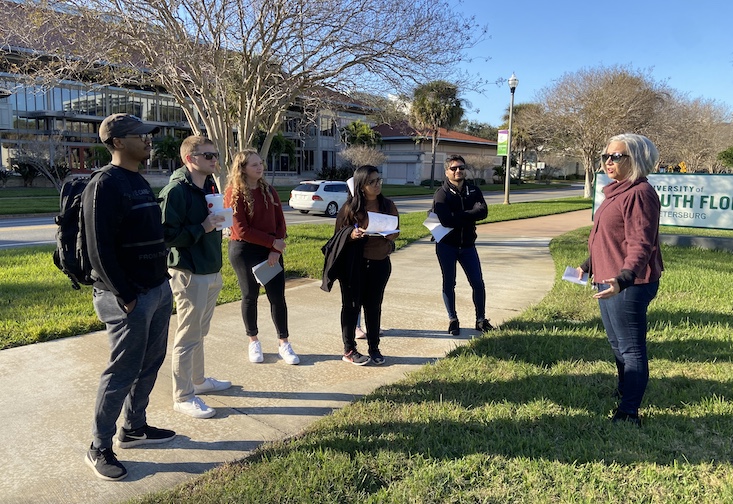By Matthew Cimitile, University Communications and Marketing
An innovative planner-in-residence class that developed a neighborhood master plan for the St. Petersburg Innovation District received an outstanding student project award from the Florida Chapter of the American Planning Association (APA) on September 6.
This first of its kind studio class at USF provided six graduate students in the Masters of Urban and Regional Planning program with the real-world experience of working on a master plan under the guidance of an urban planner.
The students’ task was to examine existing barriers within the Innovation District, a roughly one-square-mile area south of downtown St. Petersburg that is home to more than 50 organizations in the marine science, health, technology and education space, including USF St. Petersburg. The students then recommended solutions that would foster a desirable, integrated urban community.
“The intent of this class was to shepherd students through a real-life project, working with a client to put together a scope of work and then spending the semester creating the deliverables,” said Amber Dickerson, who taught the class and is an urban planner. “I was very impressed by the volume of creative ideas the students had as well as their professionalism and work ethic.”
Students researched the current and future challenges and needs of the district, conducted walking audits to inventory assets and interviewed stakeholders. They then developed a set of recommendations around four key themes:
- Mobility or how to get around the district;
- Wayfinding or how to navigate the district;
- Institutional partnerships or how to strengthen connections among organizations in the district; and
- Activating edges or how the area acts with surrounding neighborhoods.
“This class let us explore new possibilities when it came to planning,” said Beneetta Mary Jose, one of the students in the class. “We went into the field to understand the problems directly through conversations with stakeholders and our own observations, and then came back with solutions that could be adopted because they aligned with current city or district policies.”
During the semester, they also held two presentations with stakeholders and city officials, which helped to refine the final recommendations within the master plan.
“It was tremendous for these students to engage with other professionals and see how they think,” Dickerson said. “And it was a priceless experience for them to get the chance to speak in front of an audience like that with the pressure and needing to keep track of time and articulate your vision.”
“As important as it was to analyze large planning documents and connecting what is in those documents to what we see in the field during this class, learning soft skills such as public speaking, time management and understanding financial constraints in budgets was equally as significant,” Jose said.
The master plan included recommendations on mobility from enhancing pedestrian connectivity to creating mobility hubs that offer options for bike sharing, buses, driving and more. For placemaking, the students suggested creating more greenspaces, enhancing trails through wayfinding and using multiple art mediums. They also recommended renovating and increasing events at Poynter Park to attract more people to the waterfront greenspace and enhancing the district’s social media presence to advance critical partnerships.
All the recommendations were geared towards creating a vibrant and active urban area where people would want to live, work and socialize.
“What the students identified really created a forum to allow us to start digging deeper on these issues,” said Alison Barlow, executive director of the St. Petersburg Innovation District. “Plans like this can become an impetus for deeper conversations.”
The idea for the planner-in-residence class came out of discussions between Barlow and Evangeline Linkous, the director of the USF Master in Urban and Regional Planning program. Linkous was looking to create a real-world scenario for her classes. Barlow was looking for an initial planning assessment to use as a complement for a more comprehensive master plan the St. Petersburg Innovation District plans to conduct in collaboration with the city of St. Petersburg.
“There are a handful of recommendations that came out of this exercise we plan to incorporate into our bigger planning effort,” Barlow said. “This was a great example of a project that paired a real-world situation and a class, with the students learning to take something that could be theoretical and make it into a very workable product for us to use.”
